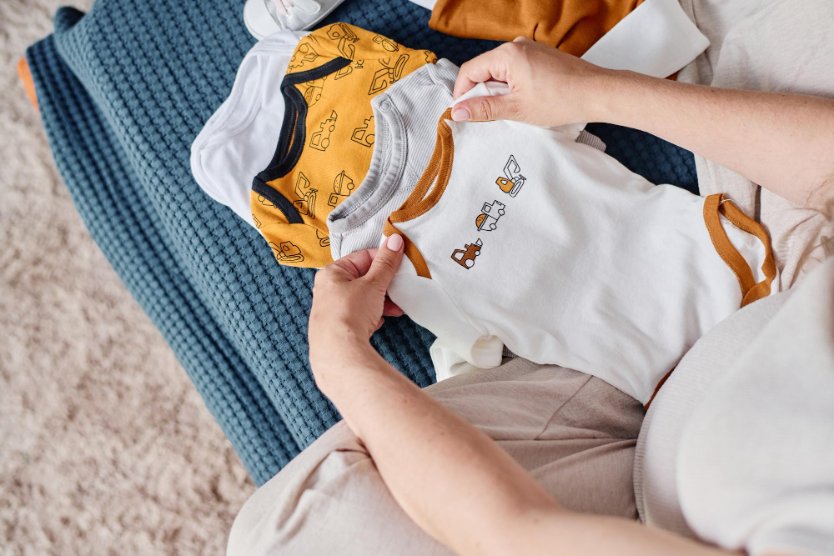Your comprehensive guide to dressing your baby safely, affordably, and comfortably from birth through their first year
Getting ready for a new baby can feel overwhelming, especially when it comes to clothing. Your newborn will need simple, comfortable items that make diaper changes easy and keep them cozy. With so many options available, knowing what you actually need (and what you can skip) will save you both money and stress.
Use our printable hospital bag and first-month checklist to ensure you have everything ready before your baby arrives.
Table of Contents
Understanding Your Newborn’s Needs
Your newborn’s clothing needs are different from older babies. Their delicate skin, rapid growth, and frequent diaper changes require specific considerations when building their wardrobe.
Why Comfort Matters Most
Newborns spend most of their time sleeping, eating, and having their diapers changed. Comfort and practicality should be your top priorities when choosing newborn clothes. Look for soft, breathable fabrics that won’t irritate their sensitive skin.
Key Comfort Features to Look For:
- Soft cotton or bamboo fabrics
- Flat seams to prevent irritation
- Easy-access openings for diaper changes
- Stretchy necklines for easy dressing
- No rough tags or scratchy materials
What Should Newborns Wear?
Newborns need simple, practical clothing that keeps them comfortable while allowing easy access for care. The basic newborn wardrobe consists of onesies, sleepers, and weather-appropriate outer layers.
During the day, a simple onesie with pants or a comfortable sleeper works perfectly. For sleep, choose appropriate sleepwear that follows safe sleep guidelines.
Size Guide and Brand Comparisons
One of the biggest challenges new parents face is understanding how baby clothes sizes work. Sizes vary dramatically between brands, and many babies don’t fit “newborn” size for long.
Understanding the Difference Between Newborn and 0-3 Clothes
The difference between newborn and 0-3 clothes is significant. Newborn sizes typically fit babies 6-9 pounds and up to 21 inches long. However, many babies are born larger than this or grow quickly in their first weeks.
Use our baby size prediction calculator to plan ahead and buy the right sizes for your baby’s growth trajectory.
| Size | Weight Range | Height Range | Typical Duration |
|---|---|---|---|
| Preemie | Up to 6 lbs | Up to 17 inches | Varies |
| Newborn | 6-9 lbs | 18.5-21 inches | 4-6 weeks |
| 0-3 months | 10-14 lbs | 21.5-24 inches | 8-12 weeks |
| 3-6 months | 15-18 lbs | 24.5-27 inches | 12-16 weeks |
Brand Sizing Variations
Different brands size their clothing differently, which can be frustrating for parents. Here’s what to expect from popular brands:
Carter’s
Sizing: Tends to run true to size
Best for: Budget-friendly basics
Note: 3-month size fits 9-12.5 lbs
Baby Gap
Sizing: Runs slightly larger
Best for: Everyday wear
Note: 3-6 month fits 12-17 lbs
Primary
Sizing: Perfect for tall, slim babies
Best for: Organic basics
Note: Consistently recommended for long babies
Hanna Andersson
Sizing: Generous fit
Best for: High-quality pajamas
Note: Excellent for growth spurts
💡 Money-Saving Tip:
Buy fewer newborn-sized items and more 0-3 month clothes. Many babies skip newborn sizes entirely or outgrow them within weeks. You can always roll up sleeves temporarily! Use our budget planning tool to allocate your spending wisely.
Baby Wardrobe Essentials
Building a practical newborn wardrobe doesn’t require hundreds of items. Focus on versatile basics that you’ll use repeatedly.
Core Clothing Items
Essential Newborn Wardrobe Checklist:
- 6-8 short-sleeve onesies or bodysuits
- 6-8 long-sleeve onesies
- 4-6 footed sleepers with zippers
- 4-5 pairs of pants or leggings
- 6-8 pairs of socks
- 2-3 hats (season appropriate)
- 2-3 swaddle blankets
- 1-2 going-home outfits
- Season-specific outer wear
Do Newborns Wear Pants?
Yes, newborns can wear pants, but they’re not always necessary. Many parents prefer footed sleepers or onesies for the first few weeks since they’re easier for diaper changes. When you do choose pants, look for ones with elastic waistbands and soft fabrics.
Footwear: Do Newborns Wear Socks and Shoes?
Newborns need socks to keep their feet warm, but they don’t need shoes until they start walking. Footed sleepers eliminate the need for separate socks and prevent them from being kicked off. When can newborns wear shoes? Save the adorable baby shoes for special occasions or when you want cute photos – they’re not necessary for development.
Should Newborns Wear Hats?
Newborns should wear hats in certain situations. Indoors, hats aren’t usually necessary unless your home is very cold. However, hats are important for:
- Going outside in any weather
- Air-conditioned environments
- The first few days after birth (hospitals often provide these)
⚠️ Sleep Safety Note:
Can newborns wear hats to sleep? Generally no – remove hats, mittens, and extra accessories before putting your baby down to sleep to prevent overheating and maintain safe sleep conditions.
Organic and Sustainable Options
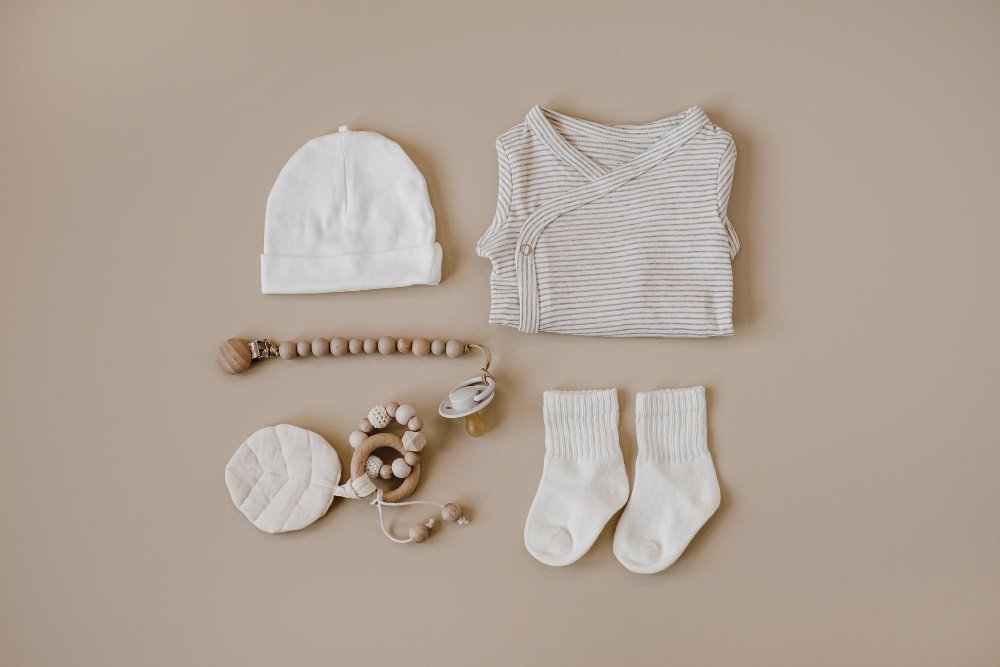
Many parents are choosing organic over conventional infant clothing for health and environmental reasons. Understanding your options helps you make informed decisions.
Benefits of Organic Baby Clothing
Organic baby clothes offer several advantages over conventional options:
Why Choose Organic?
- Healthier for baby: No harmful pesticides or chemicals touching sensitive skin
- Hypoallergenic: Reduced risk of skin irritation and allergies
- Better temperature regulation: Natural fibers breathe better
- Environmental benefits: 46% reduced global warming potential compared to conventional cotton
- Durability: Often lasts longer and maintains softness
Understanding Certifications
When shopping for organic baby clothes, look for these trusted certifications:
- GOTS (Global Organic Textile Standard): The gold standard for organic textiles, ensuring the entire production process meets strict environmental and social criteria
- OEKO-TEX Standard 100: Ensures textiles are tested for harmful substances and safe for human use
- Organic Content Standard (OCS): Verifies the amount of organic material in the final product
Best Organic Baby Clothing Brands
These brands consistently deliver quality organic options:
- Primary: GOTS-certified basics, perfect for tall babies
- Colored Organics: Beautiful neutral tones, founded by a mom
- Hanna Andersson: Premium organic pajamas and sleepwear
- Burt’s Bees Baby: Affordable organic essentials
- L’ovedbaby: Chemical-free, sustainable production
Budget-Smart Shopping Strategies
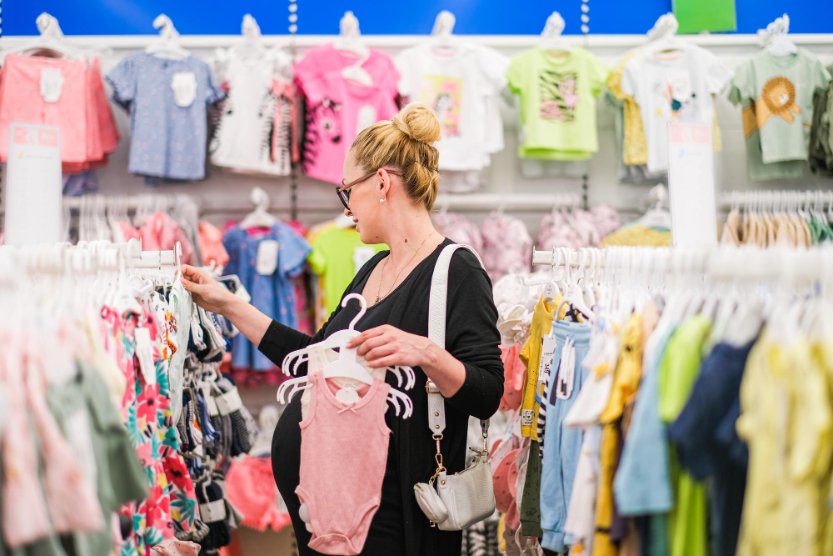
You don’t need to spend a fortune on baby clothes. Smart shopping strategies can help you build a complete wardrobe without breaking the bank.
Start with our interactive budget planning worksheet to set realistic spending goals and track your purchases throughout the first year.
How Much Should You Budget?
The average family spends $50-150 per month on baby clothes, but this can be significantly reduced with smart strategies. Baby clothes can be expensive, but they don’t have to be.
💰 Monthly Clothing Budget Guidelines:
- Newborn stage (0-3 months): $75-100 total for basics
- 3-6 months: $50-75 per month
- 6-12 months: $40-60 per month
These amounts can be reduced significantly with smart strategies. Track your actual spending with our budget worksheet.
Money-Saving Shopping Strategies
1. Buy Off-Season
Purchase winter clothes at the end of winter and summer clothes in fall. Stores offer deep discounts when clearing seasonal inventory.
2. Shop Second-Hand Smart
Baby clothes are often barely worn before being outgrown. Great places to find deals include:
- Consignment shops: Local stores with curated selections
- Facebook Marketplace: Direct buying from other parents
- ThredUp: Online consignment with return policies
- Once Upon a Child: National chain with consistent quality
3. Buy Gender-Neutral Basics
If you plan to have more children, neutral colored basics can be reused regardless of your next baby’s gender.
4. Focus on Multi-Use Items
Choose pieces that work for multiple occasions. A simple onesie can be sleepwear, everyday wear, or layered under outfits.
5. Take Advantage of Sales and Bulk Buying
Stock up on basics like onesies and socks when they’re on sale. These items are used frequently and worth buying in bulk.
Where to Buy Clothes for Newborns on a Budget:
- Target (Cat & Jack): Affordable basics with good return policy
- Walmart (Gerber): Very budget-friendly essentials
- Costco (Kirkland): Bulk organic options
- Old Navy: Frequent sales on baby basics
- Amazon: Multi-packs and subscribe-and-save discounts
Swaddling and Sleep Wear
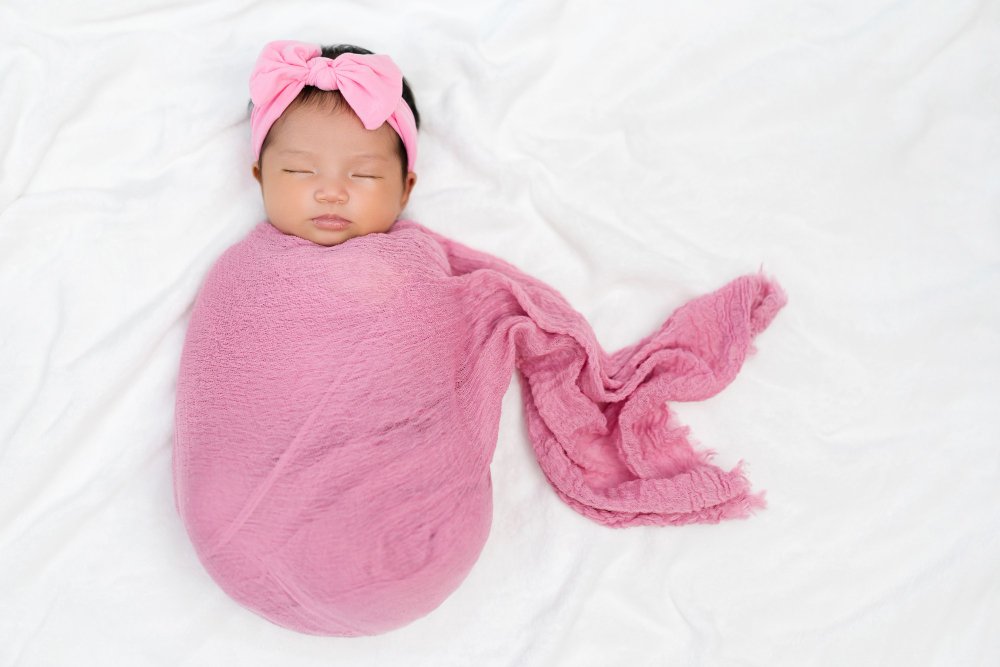
Understanding swaddling and safe sleep clothing is crucial for your newborn’s comfort and safety.
Do You Have to Swaddle a Newborn?
Swaddling isn’t required, but many newborns sleep better when swaddled. It helps recreate the snug feeling of the womb and can reduce the startle reflex that wakes babies.
How Do You Swaddle a Newborn?
There are several ways to swaddle a newborn safely:
- Traditional blanket swaddle: Using a large, thin blanket
- Swaddle wraps: Products with velcro or snaps for easier swaddling
- Sleep sacks with arm restraints: Wearable blankets that keep arms secure
⚠️ Swaddling Safety Guidelines:
- Stop swaddling when baby shows signs of rolling over (usually 2-3 months)
- Leave room for hip movement to prevent hip dysplasia
- Don’t swaddle if room temperature is above 70°F
- Never place a swaddled baby on their stomach
- Check that you can fit 2-3 fingers between the swaddle and baby’s chest
How Often to Swaddle Newborn
You can swaddle for every sleep period if your baby responds well to it. Most parents swaddle for nighttime sleep and naps during the first 2-3 months.
Do You Need Swaddle Blankets?
While you can swaddle with regular blankets, purpose-made swaddle products are often easier to use and stay secure longer. Consider having 2-3 swaddles so you always have a clean one available.
What Do Newborns Wear to Sleep?
Safe sleep clothing depends on room temperature:
- Warm rooms (70°F+): Just a diaper and light onesie
- Moderate rooms (65-70°F): Onesie and footed sleeper or sleep sack
- Cool rooms (below 65°F): Onesie, sleeper, and light blanket or warmer sleep sack
Clothing Care and Washing
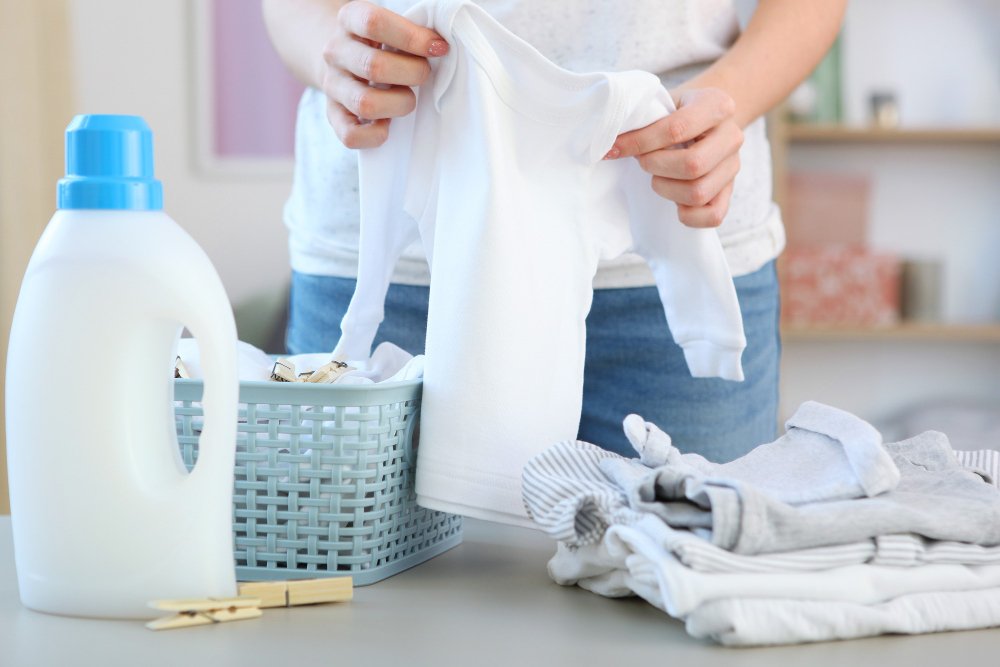
Proper care extends the life of baby clothes and keeps them safe for your little one’s sensitive skin.
When Should I Wash Newborn Clothes?
When to wash newborn clothes is a common question. You should wash all new baby clothes before the first wear to remove manufacturing chemicals and ensure they’re clean.
How to Wash Newborn Clothes
Follow these steps for washing baby clothes safely:
- Use gentle, fragrance-free detergent
- Wash in warm (not hot) water
- Pre-treat stains immediately
- Use the gentle cycle
- Double rinse if possible
How Often to Wash Baby Clothes
Wash baby clothes after each wear, especially during the newborn stage when spit-up and diaper leaks are frequent. Having multiple sets of basics ensures you’re not constantly doing laundry.
How to Fold Newborn Clothes
Efficient folding saves space and keeps clothes organized:
- Onesies: Fold in thirds lengthwise, then fold up from bottom
- Sleepers: Fold arms across chest, then fold in half
- Small items: Roll socks and hats to save space
Seasonal and Climate Considerations
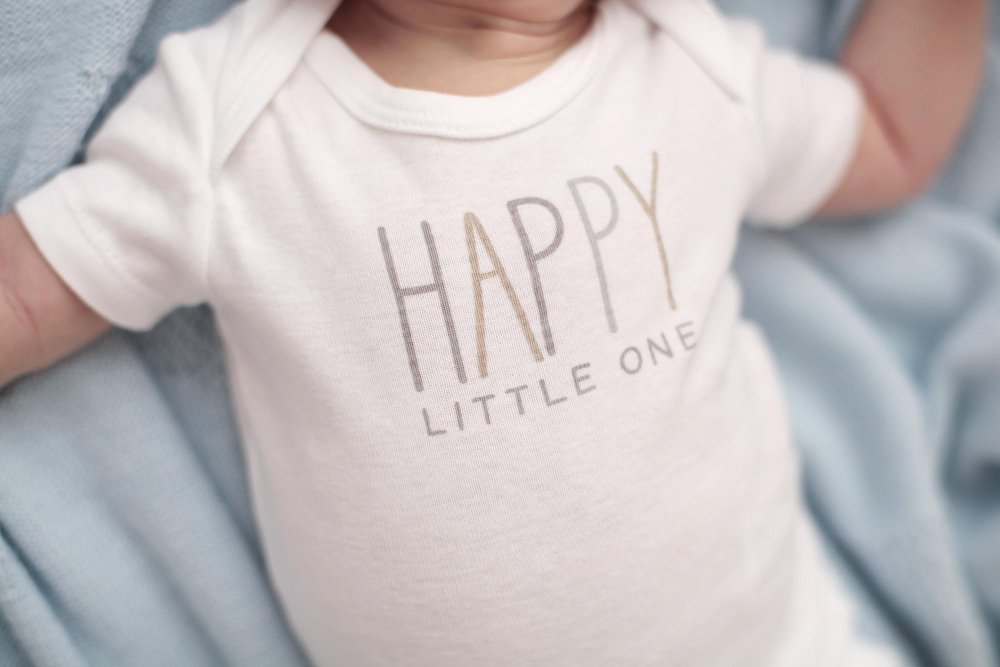
Your baby’s clothing needs vary significantly based on when they’re born and your local climate.
Plan ahead with our seasonal clothing timeline planner to see exactly what your baby will need in each season and when to shop for the best deals.
Summer Babies
Dressing newborns for summer heat requires lightweight, breathable fabrics and sun protection.
Summer Essentials:
- Lightweight cotton onesies
- Thin sleep sacks instead of blankets
- Sun hats with brims
- Light cardigan for air conditioning
- UV-protective clothing for outdoor time
Winter Babies
Winter newborns need winter clothes for babies that provide warmth without overheating.
Winter Essentials:
- Warm fleece or wool sleepers
- Knit hats and mittens
- Bunting or snowsuit for outdoors
- Thermal onesies for layering
- Warm but breathable sleep sacks
How Long Do Newborn Clothes Last?
Most newborn clothes are outgrown within 4-8 weeks, though this varies by baby. Some babies never fit newborn sizes, while others wear them for two months. This is why many experts recommend buying fewer newborn items and more 0-3 month clothes.
Use our size prediction calculator to estimate when your baby will transition to different sizes based on their current measurements.
Safety Guidelines
Choosing safe, non-toxic baby clothes is essential for your newborn’s health and wellbeing.
⚠️ Critical Safety Guidelines:
- Avoid clothes with small buttons, ribbons, or decorative items that could become choking hazards
- Choose snug-fitting sleepwear or flame-retardant clothing
- Skip clothes with long ties or drawstrings
- Ensure decorations are sewn on securely
- Remove hats, mittens, and loose items before sleep
- Check for rough seams or tags that could irritate skin
Fabric Safety
Choose safe fabrics for newborn clothing that won’t harm your baby’s delicate skin:
- Best choices: Organic cotton, bamboo, merino wool
- Avoid: Synthetic materials that don’t breathe, rough textures, chemically treated fabrics
- Look for: Hypoallergenic materials if your baby has sensitive skin
Frequently Asked Questions
For the newborn stage, you need: 6-8 onesies, 4-6 sleepers, 6-8 pairs of socks, 2-3 hats, and 3-4 pairs of pants. This provides enough for daily changes while allowing time for laundry. Remember, babies outgrow newborn sizes quickly, so don’t over-buy.
Buy a few newborn items but focus on 0-3 month sizes. Many babies are born too large for newborn clothes or outgrow them within weeks. You can always roll up sleeves temporarily, and 0-3 month clothes provide better value.
For everyday basics, focus on comfort and safety over price. However, investing in a few high-quality pieces (like organic pajamas or special occasion outfits like christening dresses) can be worth it for durability and hand-me-down potential.
Most babies transition out of newborn-specific needs around 3-4 months. You can start buying regular baby clothes instead of specialized newborn items once they’re sleeping longer stretches and have better head control.
Yes, newborns need gentler care. Use fragrance-free, hypoallergenic detergent and avoid fabric softeners. Dryer sheets aren’t recommended for baby clothes as they can irritate sensitive skin.
Pre-treat stains immediately with cold water. For tough stains, make a paste with baking soda and water, or use enzyme-based stain removers designed for babies. Never use bleach on baby clothes.
Organic baby clothes are made from materials grown without harmful pesticides and chemicals. They’re gentler on sensitive skin, more environmentally friendly, and often more durable. Look for GOTS certification for the highest standards.
No, remove hats before putting your baby down to sleep. Newborns can overheat easily, and loose items in the crib pose safety risks. Use a sleep sack or appropriate-weight sleeper instead.
Essential Shopping Checklist by Month
Use this timeline to plan your purchases and avoid buying too much too early. For a complete printable version, check out our hospital bag and first-month checklist tool.
Before Baby Arrives:
- 3-4 newborn onesies
- 6-8 0-3 month onesies
- 2-3 newborn sleepers
- 4-5 0-3 month sleepers
- 2 going-home outfits (different sizes)
- Basic accessories (hats, socks, mittens)
First Month:
- Assess what sizes baby actually needs
- Add more of the size that fits
- Stock up on basics you’re using most
2-3 Months:
- Start buying 3-6 month sizes
- Consider seasonal needs for upcoming weather
- Sell or donate outgrown items
Brand Recommendations by Budget
| Budget Level | Best Brands | Price Range | Best For |
|---|---|---|---|
| Budget-Friendly | Carter’s, Gerber, Cat & Jack | $3-15 per item | Everyday basics, frequent changes |
| Mid-Range | Baby Gap, Old Navy, H&M | $8-25 per item | Style + function, gifts |
| Premium | Primary, Colored Organics | $15-40 per item | Organic options, sensitive skin |
| Luxury | Hanna Andersson, Petit Bateau | $25-60 per item | Special occasions, hand-me-downs |
Conclusion
Building the perfect newborn wardrobe doesn’t have to be overwhelming or expensive. By focusing on comfort, safety, and practicality, you can create a collection that serves your baby well throughout their first year.
Essential Strategies to Remember:
- Start small: Buy fewer newborn sizes and more 0-3 month clothes. You can always add more based on your baby’s actual needs.
- Prioritize comfort: Choose soft, breathable fabrics with easy-access features for diaper changes.
- Think budget-smart: Use second-hand shopping, off-season buying, and gender-neutral basics to save money without sacrificing quality.
- Consider organic: If budget allows, organic clothes offer health and environmental benefits, especially for sensitive skin.
- Focus on safety: Avoid choking hazards, choose appropriate sleepwear, and follow safe sleep guidelines.
- Plan seasonally: Consider your climate and when your baby will actually wear certain sizes.
Your Action Plan:
- Before baby arrives: Buy minimal newborn basics and focus on 0-3 month essentials
- First month: Assess what sizes and styles work best for your baby
- Ongoing: Buy ahead in larger sizes during sales, focusing on versatile pieces
- Hand-me-downs: Set up systems to reuse baby clothes and pass items to other families
Ready to get started? Use our practical tools to make the process easier:
- Hospital bag and first-month checklist – Never forget essential items
- Size prediction calculator – Plan purchases for future growth
- Budget planning worksheet – Track spending and save money
- Seasonal timeline planner – Shop at the right times for best deals
Remember, the most important thing is that your baby is comfortable, safe, and loved. Whether you choose budget basics or organic luxury items, what matters most is that the clothes meet your family’s needs and values. Don’t feel pressured to buy everything at once – you’ll learn what works best as you go, and there’s always time to adjust your approach.
Trust your instincts, start with the essentials, and enjoy dressing your little one in those adorable tiny clothes. This phase goes by quickly, so focus on the practical needs while savoring the sweet moments of your baby’s first year.

